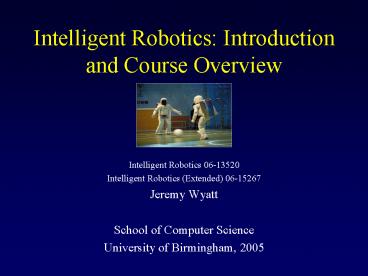Intelligent Robotics: Introduction and Course Overview PowerPoint PPT Presentation
1 / 23
Title: Intelligent Robotics: Introduction and Course Overview
1
Intelligent Robotics Introduction and Course
Overview
- Intelligent Robotics 06-13520
- Intelligent Robotics (Extended) 06-15267
- Jeremy Wyatt
- School of Computer Science
- University of Birmingham, 2005
2
Plan
- Intellectual aims of the module
- Task description
- Introduction to hardware and software
- Using robots to understand intelligence
3
Module aims
- Give an appreciation of the issues that arise
when designing complete, physically embodied
autonomous agents. - Introduce some of the most popular methods for
controlling autonomous mobile robots. - Give hands on experience of engineering design.
- Encourage independent thought on possible
cognitive architectures for autonomous agents.
4
What you will be able to do
- Design, build and program simple autonomous
robots. - Implement standard signal processing and control
algorithms. - Describe and analyse robot processes using
appropriate methods. - Write a detailed report on a robot project.
- Carry out and write up investigations using
appropriate experimental methods.
5
Basic Hardware
- IR sensors (long, medium, short)
- Whiskers
- Microswitches
- DC motors
- Servo motors
- Odometers
- Sonar
6
Additional Hardware
- PC104 board Handyboard
Sensors
PC104 (Linux)
HB
USB
Motors
USB
Camera
7
Coding on the PC104
- Vision routines can be written easily using
extensive libraries from Intel - Multiple processes threads are wrapped
- Download and Run Managers
- Support on Handyboard for
- pulse counting
- new compass
- new sonars
- smooth pwm
8
Hardware a warning
- Please take extreme care in handling of all
hardware - no loose connections
- tidy soldering
- careful charging
- check static
- if you are not 100 sure then ASK
- We will not be able to replace severely broken
kits (you will have to transfer module)
9
First Week
- Handyboard IC
- Aim to build a complete exploring robot by end of
week 2 - will familiarise you with sensors and their
properties - will give you practice in robot construction
10
Base Task Description
- Robot Rubbish Clear up
- arena with four drop zones
- bottles (green)
- tennis balls (yellow)
- pepsi cans (blue)
- coke cans (red)
- squiggle ball (any)
- collect and correctly deliver the rubbish
- 2 robots in each bout of 5 mins
11
Base Task Description
- Scoring scheme in assessment handout
- Two demos (1 public, 1 private)
- Best of two demos
- Competition score
- influences demo mark
- not the only factor
- Private demos on the 22nd, 24th and 25th November
- Public demo 30th November 2-4pm
- Last Years results
12
Assessment Outline
- Assessment by demonstration and report
- Report must be
- 25 pages maximum
- 10 pt minimum
- Hand in 12 noon on
- 8th December
13
Course Team
- Jeremy Wyatt
- Lecturer
- Noel Welsh
- Teaching Assistant
- Aleem Hossain, Arjun Chandra
- Demonstrators
- Ben Stone
- system software support
- Richard Pannell, Bert Dandy
- hardware support
14
Whats Easy is Hard
- Easy expert systems, mathematics, chess
- Hard seeing, language understanding, moving
around, making a cup of tea, common sense - Whats easy for humans is hard for computers and
vice versa. Why?
15
The Whole Iguana
- AI commonly studies aspects of intelligence
separately - narrow domain high performance
- In 1976, philosopher Dan Dennett suggested
putting it all together, but - with a low level of performance
16
The Whole Iguana
- ... why not obtain one's simplicity and scaling
down by attempting to model a whole cognitive
creature of much less sophistication than a human
being?... a turtle, perhaps ... but considering
the abstractness of the problems properly
addressed in AI ... one does not want to bogged
down in the cognitive eccentricities of turtles
if the point of the exercise is to uncover very
general, very abstract properties that will apply
as well to the cognitive organisation of human
beings. So why not make up a whole cognitive
creature, a Martian three-wheeled iguana, say,
and an environmental niche for it to cope with? I
think such a project could teach us a great deal
about the deep principles of human cognitive
psychology
17
Experiments with vehicles
- Behaviour of agents was more complex than their
mechanisms - Behaviour depended on the environment as well as
the agent - Hard to infer mechanism from behaviour alone
18
Experiments with vehicles
- Valentino Braitenberg -
- Law of uphill analysis
- and downhill invention
- My Conclusion synthesizing agents may have
something to offer in understanding our minds
19
Why build robots to understand minds?
- All naturally occuring intelligence is embodied
- So robots are in some ways similar systems
- Robots, like animals exploit their environments
to solve specific tasks - There are no general purpose animals why
should there be general purpose robots? - David MacFarland
20
Lessons from nature
- Gannets wings half open to
- control dive
- Fold wings to avoid damage
- Not at a constant distance, but at
- a constant time
- Birds have detectors that
- calculate time to impact
21
Task specific robots
- Polly the tour guide exploits assumptions about
environment to perform task quickly
22
Lessons from nature 2
- Other animals are capable of a surprising degree
of manipulative ability e.g. Betty the crow who
can make tools - Sometimes we can use robots to
- test theories of how specific
- animals work e.g. cricket
- phonotaxis
23
Wrap up
- By synthesising intelligent robots we can address
deep questions about the nature of intelligence - Robots, like animals, are embodied
- We can use the task-environment dynamics to
constrain our computational problems

